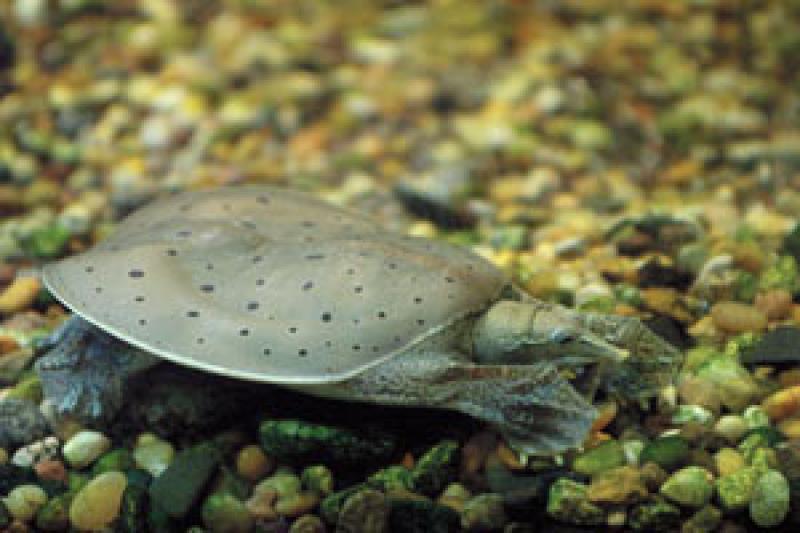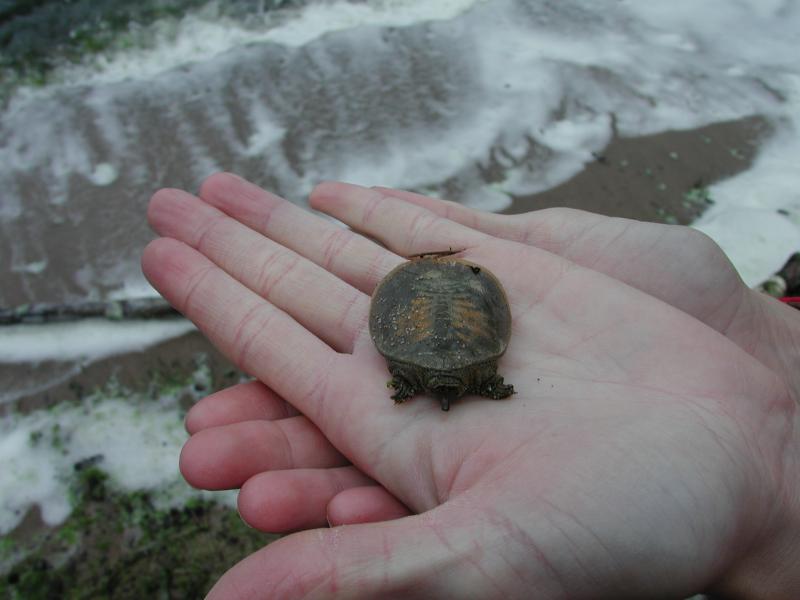Spiny Softshell
Apalone spinifera (LeSueur, 1827)
- Class
- Chelonia (Turtles)
- Family
- Trionychidae (Softshell Turtles)
- State Protection
- Special Concern
Listed as Special Concern by New York State: at risk of becoming Threatened; not listed as Endangered or Threatened, but concern exists for its continued welfare in New York; NYS DEC may promulgate regulations as to the taking, importation, transportation, or possession as it deems necessary.
- Federal Protection
- Not Listed
- State Conservation Status Rank
- S2S3
Imperiled or Vulnerable in New York - Very vulnerable, or vulnerable, to disappearing from New York, due to rarity or other factors; typically 6 to 80 populations or locations in New York, few individuals, restricted range, few remaining acres (or miles of stream), and/or recent and widespread declines. More information is needed to assign either S2 or S3.
- Global Conservation Status Rank
- G5
Secure globally - Common in the world; widespread and abundant (but may be rare in some parts of its range).
Summary
Did you know?
Spiny softshells are able to breathe while underwater, allowing them to spend extended periods of time underwater. They can exchange oxygen and carbon dioxide directly through their skin, especially through membranes that line their throat and cloaca, while in water.
State Ranking Justification
These turtles are known from some western counties and a disjunct population in eastern New York. Several known populations are small and seem to be in decline, and populations are under pressure from shoreline development, human disturbance, and invasive species.
Short-term Trends
To date, this species has been documented at twenty sites in New York, and spiny softshells continue to be documented at new locations in the state. Since 2000, individuals have been sighted at fifteen of the twenty known sites. At one site, biologists have not observed individuals during multiple surveys in recent years. That population seems to be in decline, and it may already be extirpated or on its way to extirpation.
Four of the twenty known sites have not had turtles sighted in recent years. Shoreline development, disturbance of basking and nesting areas, as well as invasive species spread, has led to a reduction in habitat, and many areas have high rates of nest predation.
Long-term Trends
The long-term trends are not known for New York. There is evidence that this species could be declining in at least parts of its range.
Conservation and Management
Threats
Threats include collection for food markets, development (Gibbs et al. 2007), and invasive species. These turtles are highly aquatic and can breathe underwater, and so they are highly affected by water pollution. Human recreation is also a threat to softshell populations due to collision with boats and getting hooked on fishing lines (Galois et al. 2002). Mechanical weed harvesters have been found to threaten populations, since softshell turtles use aquatic weed mats for feeding and basking. Potentially, a lack of high quality, undisturbed nesting and basking habitats negatively impact populations.
Conservation Strategies and Management Practices
There are several conservation strategies that could accomplish better protection and outcomes for spiny softshell populations. Avoid or minimize impediments to turtle movements; impediments may be caused by dams, habitat alterations, or human activities (Galois et al. 2002). These impediments may limit the turtles' access to suitable feeding, nesting, or hibernating sites, and they can isolate populations from one another. Maintain river buffers to prevent runoff of harmful chemicals into the water, and additionally minimize all river pollution sources (Mitchell et al. 2006). Snags in the water should only be removed when necessary for boat traffic, since these are important shelter and basking habitats (Mitchell et al. 2006). Ensure that suitable nesting areas (gravel bars) are identified and managed and/or protected from disturbances. Researchers in New York had success with fencing off a nesting area to keep out people, vehicles and predators, and then placing plastic netting over the nesting site during hatching. These measures allowed the nests to safely incubate and hatch, and protected hatchlings from predators until they could reach the water (Gibbs et al. 2007). Invasive species should be removed, especially from the shoreline. It may be beneficial to have a speed limit in some areas near shore and protect a no wake zone.
Research Needs
Research is needed to determine if spiny softshells inhabit the New York side of Lake Champlain, to better understand the distribution of the species in the rest of the state, and to determine the conservation status of the species in the state.
Habitat
Habitat
These turtles live in large rivers, impoundments, lakes, and protected bays and river mouths of the Great Lakes. Habitat ranges from areas with open sandy or soft mud bottoms with sparse aquatic vegetation to areas with submerged and floating vegetation and floating vegetation mats. They typically avoid rocky areas. Mudflats, sandbars, and floating mats of vegetation used for basking and nesting are important components of high quality habitat (Gibbs et al. 2007, Czech and Gibbs unpublished).
Associated Ecological Communities
- Backwater slough
(guide)
The aquatic community of quiet to stagnant waters in sloughs that form in embayments and old meanders that are cut off from an unconfined river or marsh headwater stream only at the upstream end by deposition of a levee.
- Confined river
(guide)
The aquatic community of relatively large, fast flowing sections of streams with a moderate to gentle gradient.
- Deepwater river
The aquatic community of very large, very deep, quiet, base level sections of streams with a very low gradient. In places the water is deep enough so that light cannot reach the river bottom.
- Great Lakes aquatic bed
(guide)
The aquatic community of the protected shoals of the Great Lakes or Lake Champlain. They occur in quiet bays that are protected from extreme wave action by islands, shoals, or barrier bars, and typically support large areas of "weeds" or aquatic macrophytes.
- Mesotrophic dimictic lake
(guide)
The aquatic community of a lake that is intermediate between an oligotrophic lake and a eutrophic lake. These lakes are dimictic: they have two periods of mixing or turnover (spring and fall); they are thermally stratified in the summer, and they freeze over and become inversely stratified in the winter.
- Oligotrophic dimictic lake
(guide)
The aquatic community of a nutrient-poor lake that typically occurs in a deep, steeply-banked basin. These lakes are dimictic: they have two periods of mixing or turnover (spring and fall), they are thermally stratified in the summer, and they freeze over and become inversely stratified in the winter.
- Reservoir/artificial impoundment
The aquatic community of an artificial lake created by the impoundment of a river with a dam. Reservoirs are constructed to collect water for municipal and/or agricultural water use, to provide hydroelectric power, and to improve opportunities for recreational activities (e.g., boating, swimming), and development.
- Unconfined river
(guide)
The aquatic community of large, quiet, base level sections of streams with a very low gradient.
- Winter-stratified monomictic lake
(guide)
The aquatic community of a large, shallow lake that has only one period of mixing each year because it is very shallow in relation to its size, and is completely exposed to winds. These lakes typically never become thermally stratified in the summer, and are only stratified in the winter when they freeze over, and become inversely stratified (coldest water at the surface). They are eutrophic to mesotrophic.
Range
New York State Distribution
Spiny softshells have been reported from several western New York counties and also a disjunct site in the Albany area. Although the turtles are found on the Vermont side of Lake Champlain, there are not yet any records from the New York side of the lake.
Global Distribution
The range of the spiny softshell extends from Montana to southern Quebec, south to northern Mexico and the Florida panhandle. Disjunct populations exist in several areas around the periphery of the range. This turtle has been introduced in the Colorado-Gila river system and in New Jersey. It is also introduced and established in southeastern Virginia (Mitchell and Southwick, 1993, Brimleyana 18:99-102).
Best Places to See
- Chadakoin River
Identification Comments
Identifying Characteristics
The spiny softshell has a flattened, oval or round top shell (carapace) that is olive or light brown, with short, spiny projections along the front edge (Gibbs et al. 2007). Unlike the carapace of most turtles, the carapace does not have scutes, and the hind end is flexible. This turtle has a long neck, and its snout resembles a snorkel. Males and juveniles have black dots and eye spots on the carapace, with a black line along the margin of the back half of the carapace. Females have a gray to brown mottled or blotched pattern on the carapace. Most turtles have two black-edged yellow stripes on each side of the head. The feet are fully webbed, and mottled or streaked with black and yellow. Males are smaller than females and have a long, thick tail, while females have a short tail that is often tucked under the edge of the carapace.
Characters Most Useful for Identification
The flattened, leathery carapace and snorkel-like snout are the characters most useful for identification.
Best Life Stage for Proper Identification
This turtle is easy to identify in all life stages from hatchling to adult.
Behavior
This turtle is quick to defend itself, making it difficult to handle safely. Turtles are quick to bite and scratch, and bites from larger individuals can be very painful.
Diet
Turtles are mainly carnivorous, and may eat crayfish, aquatic insects, snails, tadpoles, and small fish. They also eat a smaller percentage of plant material.
Best Time to See
This species usually becomes active in April. During fair weather in late spring and summer, turtles bask on steep embankments, sand bars, or floating logs. Winter is spent hibernating in soft mud on the bottom. Females nest in June or early July, often swimming long distances to favored open nesting sites such as sand bars or gravel banks close to water. Hatching occurs in late summer, but the young may overwinter in the nest and emerge the following spring (Gibbs et al. 2007).
- Present
- Reproducing
The time of year you would expect to find Spiny Softshell present and reproducing in New York.
Spiny Softshell Images
Taxonomy
Spiny Softshell
Apalone spinifera (LeSueur, 1827)
- Kingdom Animalia
- Phylum Craniata
- Class Chelonia
(Turtles)
- Order Testudines
(Turtles)
- Family Trionychidae (Softshell Turtles)
- Order Testudines
(Turtles)
- Class Chelonia
(Turtles)
- Phylum Craniata
Synonyms
- Trionyx spiniferus Le Sueur, 1827
Additional Resources
References
Ernst. C. H., and J. E. Lovich. 2009. Turtles of the United States and Canada. Second edition, revised and updated. Johns Hopkins University Press, Baltimore, Maryland. xii + 827 pp.
Galois, P., M. Leveille, L. Bouthillier, C. Daigle, and S. Parren. 2002. Movement patterns, activity, and home range of the eastern spiny softshell turtle (Apalone spinifera) in northern Lake Champlain, Quebec, Vermont. Journal of Herpetology 36:402-411.
Gibbs, J. P., A. R. Breisch, P. K. Ducey, G. Johnson, J. L. Behler, and R. C. Bothner. 2007. The amphibians and reptiles of New York state. Oxford University Press, New York. xv + 422 pp.
Mitchell, J.C., A.R. Breisch, and K.A. Buhlmann. 2006. Habitat management guidelines for amphibians and reptiles of the northeastern United States. Partners in Amphibian and Reptile Conservation, Technical Publication HMG-3, Montgomery, Alabama. 108 pp.
NatureServe. 2018. NatureServe Explorer: An online encyclopedia of life [web application]. Version 7.1. NatureServe, Arlington, Virginia. Available http://www.natureserve.org/explorer. (Accessed: August 13, 2018)
New York Natural Heritage Program. 2024. New York Natural Heritage Program Databases. Albany, NY.
Links
About This Guide
This guide was authored by: Ashley R. Ballou
Information for this guide was last updated on: November 1, 2018
Please cite this page as:
New York Natural Heritage Program. 2024.
Online Conservation Guide for
Apalone spinifera.
Available from: https://guides.nynhp.org/spiny-softshell/.
Accessed July 27, 2024.

